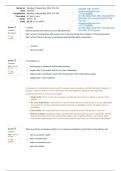Exam (elaborations)
ECS1501 ASSESSMENT 9 SEM 2 OF 2024 EXPECTED QUESTIONS AND ANSWERS
- Course
- Economics IA (ECS1501)
- Institution
- University Of South Africa (Unisa)
THIS DOCUMENT CONTAINS ECS1501 ASSESSMENT 9 SEM 2 OF 2024 EXPECTED QUESTIONS AND ANSWERS. USAE IT CORRECTLY AS A GUIDE TO SCORE ABOVE 80%
[Show more]



